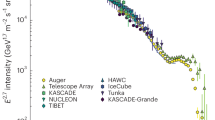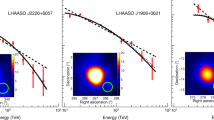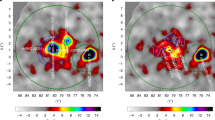Abstract
Cosmic rays are charged particles arriving at the Earth from space. Those at the highest energies are particularly interesting because the physical processes that could create or accelerate them are at the limit of our present knowledge. They also open the window to particle astronomy, as the magnetic fields along their paths are not strong enough to deflect their trajectories much from a straight line. The Pierre Auger Observatory is the largest cosmic-ray detector on Earth, and as such is beginning to resolve past observational disagreements regarding the origin and propagation of these particles.
This is a preview of subscription content, access via your institution
Access options
Subscribe to this journal
Receive 51 print issues and online access
$199.00 per year
only $3.90 per issue
Buy this article
- Purchase on Springer Link
- Instant access to full article PDF
Prices may be subject to local taxes which are calculated during checkout




Similar content being viewed by others
References
Auger, P. & Maze, R. Extensive cosmic showers in the atmosphere. C.R. Acad. Sci. II 207, 228–229 (1938)
Auger, P., Ehrenfest, P., Maze, R., Daudin, J. & Robley, A. F. Extensive cosmic-ray showers. Rev. Mod. Phys. 11, 288–291 (1939)
Biermann, P. & Sigl, G. Introduction to cosmic rays. Lect. Notes Phys. 576, 1–26 (2001)
Biermann, P., Gaisser, T. & Stanev, T. The origin of galactic cosmic rays. Phys. Rev. D 51, 3450–3454 (1995)
Greisen, K. End to the cosmic ray spectrum? Phys. Rev. Lett. 16, 748–750 (1966)
Zatsepin, G. T. & Kuzmin, V. A. Upper limit of the spectrum of cosmic rays. Zh. Eksp. Teor. Fiz. Pisma Red. 4, 114–117 (1966)
Abbasi, R. et al. First observation of the Greisen-Zatsepin-Kuzmin suppression. Phys. Rev. Lett. 100, 101101 (2008)First observation of the cosmic-ray flux suppression at the highest energies.
Sakaki, N. et al. in Proc. 27th Int. Cosmic Ray Conf. (ICRC 2001) (eds Kampert, K. H., Hainzelmann, G. & Spierling G.) 333–336 (Copernicus Gesellschaft, 2001)
Sokolsky, P. & Thomson, G. B. Highest energy cosmic rays and results from the HiRes experiment. Preprint at 〈http://arXiv.org/abs/0706.1248v1〉 (2007)
Watson, A. Recent results from the Pierre Auger Observatory – Including comparisons with data from AGASA and HiRes. Nucl. Instrum. Meth. A 588, 221–226 (2008)
Abraham, J. et al. Observation of the suppression of the flux of cosmic rays above 4×1019eV. Phys. Rev. Lett. 101, 061101 (2008)Confirmation of the cosmic-ray flux suppression at the highest energies.
Abraham, J. et al. Correlation of the highest energy cosmic rays with nearby extragalactic objects. Science 318, 938–943 (2007)Discovery of cosmic-ray arrival direction anisotropy.
Chiba, N. et al. Akeno giant air shower array (AGASA) covering 100-km2 area. Nucl. Instrum. Meth. A 311, 338–349 (1992)
Pilkington, A. et al. in Proc. XVI Int. Workshop on Deep-Inelastic Scattering and Related Topics (DIS 2008) (eds Devenish, R. & Ferrando, J.) 10.3360/dis.2008.50 (Science Wise Publishing, 2008)
Abu-Zayyad, T. et al. The prototype high-resolution Fly's Eye cosmic ray detector. Nucl. Instrum. Meth. A 450, 253–269 (2000)
De Marco, D., Blasi, P. & Olinto, A. V. On the statistical significance of the GZK feature in the spectrum of ultra high energy cosmic rays. Astropart. Phys. 20, 53–65 (2003)
Takeda, M. et al. Energy determination in the Akeno giant air shower array experiment. Astropart. Phys. 19, 447–462 (2003)
Kachelriess, M., Semikoz, D. V. & Tortola, M. A. New hadrons as ultra-high energy cosmic rays. Phys. Rev. D 68, 043005 (2003)
Gibilisco, M. Monopolonium decay as a source of ultrahigh energy cosmic rays. Nucl. Phys. Proc. 100 (Suppl.). 357–359 (2001)
Deligny, O., Letessier-Selvon, A. & Parizot, E. Magnetic horizons of UHECR sources and the GZK feature. Astropart. Phys. 21, 609–615 (2004)
Teshima, M. et al. in Proc. 28th Int. Cosmic Ray Conf. (ICRC 2003) (eds Kajita, T., Asaoka, Y., Kawachi, A., Matsubara, Y. & Sasaki, M.) 437–440 (Universal Academy, 2003)
Bellido, J. et al. in Proc. 28th Int. Cosmic Ray Conf. (ICRC 2003) (eds Kajita, T., Asaoka, Y., Kawachi, A., Matsubara, Y. & Sasaki, M.) 425–428 (Universal Academy, 2003)
Abbasi, R. U. et al. Search for cross-correlations of ultra-high-energy cosmic rays with BL Lacertae objects. Astrophys. J. 636, 680–684 (2006)
Uchihori, Y. et al. Cluster analysis of extremely high energy cosmic rays in the northern sky. Astropart. Phys. 13, 151–160 (2000)
Berezinsky, V. On transition from galactic to extragalactic cosmic rays. J. Phys. Conf. Ser. 47, 142–153 (2006)
Stanev, T. The transition from galactic to extragalactic cosmic rays. Nucl. Phys. Proc. 168 (Suppl.). 252–257 (2007)
Abraham, J. et al. Properties and performance of the prototype instrument for the Pierre Auger Observatory. Nucl. Instrum. Meth. A 523, 50–95 (2004)
Abraham, J. et al. Correlation of the highest-energy cosmic rays with the positions of nearby active galactic nuclei. Astropart. Phys. 29, 188–204 (2008)
Sommers, P. in Proc. 29th Int. Cosmic Ray Conf. (ICRC 2005) Vol. 7 (eds Sripathi Acharya, B. et al.) 387–390 (Tata Institute of Fundamental Research, 2005)
Newton, D. in Proc. 30th Int. Cosmic Ray Conf. (ICRC 2007) (eds Caballero, R. et al.) 323–325 (Universidad Nacional Autonoma de Mexico, 2007)
Kampert, K. H. Ultra high-energy cosmic ray observations. J. Phys. Conf. Ser. 120, 062002 (2008)
Veron-Cetty, M. et al. A catalogue of quasars and active nuclei: 12th edition. Astron. Astrophys. 455, 773–776 (2006)
George, M. et al. On active galactic nuclei as sources of ultra-high energy cosmic rays. Mon. Not. R. Astron. Soc. 388, L59–L63 (2008)
Ghisellini, G. et al. Ultra-high energy cosmic rays, spiral galaxies and magnetars. Preprint at 〈http://arxiv.org/abs/0806.2393〉 (2008)
Abbassi, R. U. et al. Search for correlations between HiRes stereo events and active galactic nuclei. Preprint at 〈http://arXiv.org/abs/0804.0382〉 (2008)
LHC. 2008. 〈http://lhc2008.web.cern.ch/lhc2008〉 (2008)
Kawai, H. et al. Telescope array experiment. Nucl. Phys. Proc. 175–176 (Suppl.). 221–226 (2008)
Ebisuzaki, T. et al. The JEM-EUSO project: Observing extremely high energy cosmic rays and neutrinos from the International Space Station. Nucl. Phys. Proc. 175–176 (Suppl.). 237–240 (2008)
Orbiting wide-angle light-collectors (OWL). 〈http://owl.gsfc.nasa.gov〉 (2004)
Falcke, H. et al. Detection and imaging of atmospheric radio flashes from cosmic ray air showers. Nature 435, 313–316 (2005)
Acknowledgements
We express our gratitude to many people, too many to mention individually, in the AMANDA and Auger Collaborations, who guided us through the cosmic-ray world over the years. We especially thank our mentor A. Filevich, whom introduced us to cosmic-ray physics and the scientific world.
Author information
Authors and Affiliations
Corresponding author
Rights and permissions
About this article
Cite this article
Bauleo, P., Martino, J. The dawn of the particle astronomy era in ultra-high-energy cosmic rays. Nature 458, 847–851 (2009). https://doi.org/10.1038/nature07948
Issue Date:
DOI: https://doi.org/10.1038/nature07948
This article is cited by
Comments
By submitting a comment you agree to abide by our Terms and Community Guidelines. If you find something abusive or that does not comply with our terms or guidelines please flag it as inappropriate.



